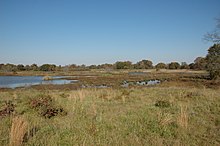
The Clean Water Rule is a 2015 regulation published by the U.S. Environmental Protection Agency (EPA) and the United States Army Corps of Engineers (USACE) to clarify water resource management in the United States under a provision of the Clean Water Act of 1972.[1] The regulation defined the scope of federal water protection in a more consistent manner, particularly over streams and wetlands which have a significant hydrological and ecological connection to traditional navigable waters, interstate waters, and territorial seas. It is also referred to as the Waters of the United States (WOTUS) rule, which defines all bodies of water that fall under U.S. federal jurisdiction. The rule was published in response to concerns about lack of clarity over the act's scope from legislators at multiple levels, industry members, researchers and other science professionals, activists, and citizens.[2]
The rule was contested in litigation. In 2017 the Trump administration announced its intent to review and rescind or revise the rule.[3] A Supreme Court ruling on January 22, 2018 returned the rule's nationwide authority after the rule was decided to be illegal by a lower court. It gave back jurisdiction previously complicated by decisions from the circuit courts of appeals. Two weeks later, the Trump administration formally suspended the rule until February 6, 2020.[4] The Trump administration formally repealed the WOTUS rule on September 12, 2019[5] and published a replacement rule on April 21, 2020.[6] On August 30, 2021, the United States District Court for the District of Arizona threw out the 2020 replacement rule.[7][8]
USACE and EPA published a revised definition of WOTUS on January 18, 2023, restoring the pre-2015 regulations on the scope of federal jurisdiction over waterways, effective March 20, 2023.[9]
On May 25, 2023, the United States Supreme Court ruled in the case Sackett v. Environmental Protection Agency that only wetlands and permanent bodies of water with a "continuous surface connection" to "traditional interstate navigable waters" are covered by the Clean Water Act, narrowing the application of the Clean Water Rule.[10][11]
- ^ U.S. Army Corps of Engineers and Environmental Protection Agency (EPA). "Clean Water Rule: Definition of 'Waters of the United States'." Final Rule. Federal Register, 80 FR 37053. 2015-06-29.
- ^ "What the Clean Water Rule Does". EPA. May 18, 2016. Archived from the original on March 29, 2017.
- ^ USACE and EPA. "Intention To Review and Rescind or Revise the Clean Water Rule." Notice. 82 FR 12532. 2017-03-06.
- ^ Davenport, Coral (January 31, 2018). "E.P.A. Blocks Obama-Era Clean Water Rule". The New York Times.
- ^ Cite error: The named reference
nytimes repealwas invoked but never defined (see the help page). - ^ Pasqua Yaqui Tribe et al v. United States Environmental Protection Agency (D. Arizona 2021-08-30) ("The seriousness of the Agencies’ errors in enacting the NWPR, the likelihood that the Agencies will alter the NWPR’s definition of “waters of the United States,” and the possibility of serious environmental harm if the NWPR remains in place upon remand, all weigh in favor of remand with vacatur."), Text.
- ^ Grandoni, Dino; Dennis, Brady (August 30, 2021). "Federal judge throws out Trump administration rule allowing the draining and filling of streams, marshes and wetlands". The Washington Post.
- ^ Cite error: The named reference
Revised WOTUS 1/18/2023was invoked but never defined (see the help page). - ^ Supreme Court of the United States (May 25, 2023). "SACKETT ET UX . v. ENVIRONMENTAL PROTECTION AGENCY ET AL" (PDF).
- ^ Ann E. Marimow; Timothy Puko; Robert Barnes (May 25, 2023). "Supreme Court weakens EPA power to enforce Clean Water Act". The Washington Post.
© MMXXIII Rich X Search. We shall prevail. All rights reserved. Rich X Search
